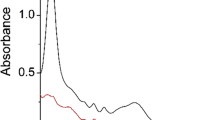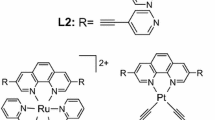Abstract
Polypyridyl ruthenium (Ru) complexes 1–3 were prepared. Their photophysical properties were investigated by UV-Vis absorption and luminescence emission spectra. The luminescent lifetimes of these Ruthenium complex were prolonged by more than 5 folds (τ = 2.50 μs for complex 3) when compared with the parent Ru complex 1 (τ = 0.45 μs). We propose that the extended luminescent lifetime of complex 3 is due to the equilibrium between 3MLCT state and the pyrene localized 3π-π* triplet state (3IL). The luminescent O2-sensing property of the complexes in solution and the IMPEK-C polymer film were studied, and the O2 sensing was quantified with the two-site model. The oxygen-sensing property of the Ru complexes can be improved by 104-fold with extension of the luminescent lifetimes. For example, the quenching constant K SV was improved from 0.0023 Torr−1 of 1 to 0.2393 Torr−1 for 3. Our results demonstrated a versatile approach for the preparation of Ru (II) polypyridine complexes with extended luminescent lifetimes as functional materials, for example, for luminescent oxygen-sensing applications.
Similar content being viewed by others
References
Lakowicz, J. R., Principles of Fluorescence Spectroscopy, 2nd Ed.; Kluwer Academic/Plenum Publishers: New York, 1999
Wolfbeis, O., Narayanaswamy, R., Optical sensors: Industrial, Environmental and Diagnostic Applications; Springer-Verlag: Berlin-Heidelberg, 2004
Goui, J. F.; Bares, F.; Birot, D.; André, J. C., Sens. Actuators B 1997 39, 401–406
Lu, X.; Winnik, M. A., Chem. Mater. 2001 13, 3449–3463
Koo, L. Y. E.; Cao, Y. F.; Kopelman, R.; Koo, S. M.; Brasuel, M., Philbert, M. A., Anal. Chem. 2004 76, 2498–2505
Bacon, J. R.; Demas, J. N., Anal. Chem. 1987 59, 2780–2785
Amao, Y.; Okura, I., Sens. Actuators B 2003 88, 162–167
Wu, X.; Cong, Y.; Liu, Y.; Ying, L. B., J. Sol. Gel. Sci. Technol. 2009 49, 355–363
Zhong, W.; Urayama, P.; Mycek, M. A., J. Phys. D: Appl. Phys. 2003 36, 1689–1695
Wang, X.; Guerzo, A. D.; Schmehl, R. H., J. Photochem. Photobiol. C 2004 5, 55–77
McClenaghan, N. D.; Leydet, Y.; Maubert, B.; Indelli, M. T.; Campagna, S., Coord. Chem. Rev. 2005 249, 1336–1350
Baba, A. I.; Shaw, J. R.; Simon, J. A.; Thummel, R. P.; Schmehl, R. H., Coord. Chem. Rev. 1998 171, 43–49
Glazer, E. C.; Magde, D.; Tor, Y., J. Am. Chem. Soc. 2007 129, 8544–8551
Ji, S.; Wu, W.; Wu, Y.; Zhao, T.; Zhou, F.; Yang, Y.; Zhang, X.; Liang, X.; et al., Analyst 2009 134, 958–965
Mills, A.; Lepre, A., Anal. Chem. 1997 69, 4653–4659
Vasil’ev, V. V.; Borisov, S. M., Sens. Actuators B 2002 82, 272–276
Wang, Z.; Chen, T.; Xu, J., Macromolecules 2000 33, 5672–5679
Chuai, Y.; Lee, D.; Zhen, C.; Min, J.; Kim, B.; Zou, D., Syn. Metals 2004 145, 259–264
Ji, S.; Wu, W.; Wu, W.; Song, P.; Han, K.; Wang, Z.; Liu, S.; Guo, H.; et al., J. Mater. Chem. 2010 20, 1953–1963
Glazer, E. C.; Magde, D.; Tor, Y., J. Am. Chem. Soc. 2005 127, 4190–4192
Mariappan, M.; Maiya, B. G., Eur. J. Inorg. Chem. 2005 11, 2164–2173
Kozlov, D. V.; Tyson, D. S.; Goze, C.; Ziessel, R.; Castellano, F. N., Inorg. Chem. 2004 43, 6083–6092
Oter, O.; Ertekin, K.; Dayan, O.; Cetinkaya, B., J. Fluoresc. 2008 18, 269–276
Author information
Authors and Affiliations
Corresponding author
Additional information
Jianzhang ZHAO obtained his Ph.D. degree at Jilin University in 2000. Then he did research in South Korea (POSTECH), Germany (Max-Plank Research Unit of Protein Folding) and United Kingdom (University of Bath). In 2005, he took a position as a full professor at Dalian University of Technology. His current research interests include molecular sensors and photophysics, such as boronic acid sensors and oxygen sensors. More recently he focused on the study of phosphorescent metal complexes.
About this article
Cite this article
Ji, S., Wu, W., Wu, W. et al. Synthesis of polypyridyl ruthenium complexes with 2-(1-aryl)-1H-imidazo[4,5-f]-1,10-phenanthroline ligand and its application for luminescent oxygen sensing. Front. Chem. China 5, 193–199 (2010). https://doi.org/10.1007/s11458-010-0103-y
Received:
Accepted:
Published:
Issue Date:
DOI: https://doi.org/10.1007/s11458-010-0103-y




